
Hardwood Species

African Cedar (Bosse)
Botanical Name:
Guarea cedrata spp.
Also Known as:
Bosse, bossé claire, bosasa, lisasa, dumbala.
Origin:
Nigeria, Ivory Coast, Liberia, Gabon, Cameroon and other tropical African countries.

Bosse is an elegant species which exhibits a golden tan teak color when freshly milled, turning in to a caramel light brown color over time. It has a very uniform color from board to board. It can be used on both residential and commercial installations since it is one of the hardest woods available in the market with twice the hardness of Red Oak.
%20.jpg)
African Cherry (Makore)
Botanical Name:
Tieghemella heckelii
Also Known as:
Makore, Abacu, Aganokwe, Baku, Douka, Okolla
Origin:
Tropical and West Africa
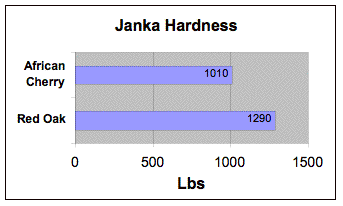
African Cherry ranges in color from the pink to light red to lighter brown spectrum, with a straight, sometimes-interlocked grain and with a medium to very fine texture.
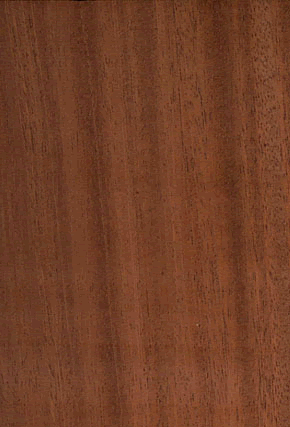
African Mahogany
Botanical Name:
Khaya spp.
Also Known as:
Akuk, Bandoro, Benin mahogany, Bisselon, Bitehi, Diala iri, Eri Kiree, Khaya mahogany, Ogwango, Senegal mahogany.
Origin:
West Africa: Ivory Coast, Gabon, Senegal, Ghana, and Nigeria.
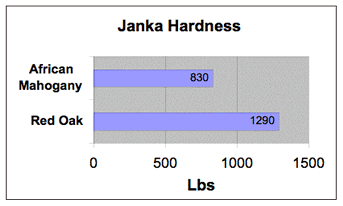
African mahogany is a commercial name normally associated with the Khaya species which is part of the mahogany family, but are separate from the Swietenia species of the Americas. The Khaya species tend to be lighter in color, generally more of a salmon/pink in tint.
African mahogany is sometimes confused with Sapele (Entandrophragma cylindricum) because of its similar color and grain, however African Mahogany is a much softer wood than Sapele.


African Rosewood (Bubinga)
Botanical Name:
Guibourtia, demeusei
Also Known as:
African Rosewood, Buvenga, Essingang, Kevazingo, Ovang, Waka.
Origin:
Central Africa, primarily Cameroon and Gabon.
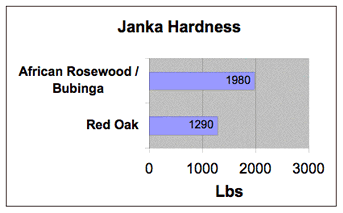
Bubinga is a beautiful dense hardwood with a rose-colored background and darker purple striping. It exhibits very uniform color and grain, and undergoes a medium degree of color change from a pinkish rose when freshly milled to a deep burgundy red color when aged.

African Walnut
Botanical Name:
Coula Edulis
Also Known as:
African Tigerwood, Gabon Nut, Congowood, Anamemila, Apopo, Sida (Nigeria), Bombulu (Congo), Dibetou (Gabon, Ivory Coast), Mpengwa (Ghana)
Origin:
Sierra Leone. Nigeria, Congo, Angola, Gabon, Ivory Coast, and Ghana
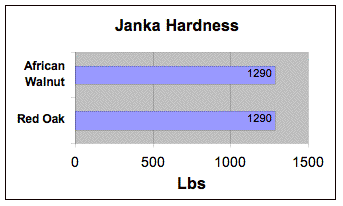
This African wood exhibits a color range from dark bronze to chocolate brown with irregular dark lines. It is becoming popular in Europe and North America for its natural beauty and distinct grain patterns resembling Tigerwood but in darker Walnut color.
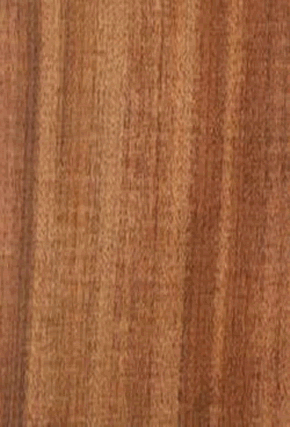
Afrormosia
Botanical Name:
Pericopsis, elata
Also Known as:
African Teak
Origin:
West Africa, primarily Ghana and the Ivory Coast.
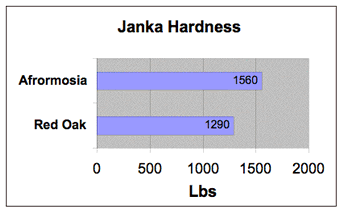
Afrormosia closely resembles teak and is often referred as African teak. It is a heavy and dense wood that is extremely durable and very resistant to termites and humidity. This wood has a wide range of uses both for interior and exterior applications including paneling, boat building, stairs, flooring, high-end joinery, cabinetmaking, farm implements, decks and marine piling.
Afrormosia is very uniform in color range but undergoes a large degree of color change over time with pronounced darkening from a golden tan color when freshly milled to a uniform medium brown when fully aged.

Amberwood Peroba
Botanical Name:
Aspidosperma polyneuren
Also Known as:
Peroba, Peroba Rosa, amargoso, guatambu-amarelo, ibirá-ró-mí, marela, paroba-amargosa
Origin:
Brazil, Paraguay, Argentina
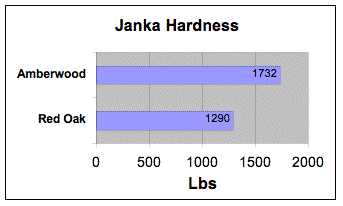
When freshly sanded and finished this floor will appear very pink with light yellow streaks running like flames through the length of the boards. With time the pink will change to an orangey yellow to give an overall amber floor. Amberwood's grain is iridescent, extremely fine and even. It is a very hard and good wearing wood
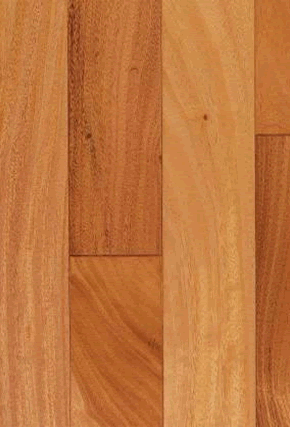
Amendoim
Botanical Name:
Pterogyne nitens
Also Known as:
Guiaro, Ibiraro, Pau Fava, Vivaro
Origin:
Brazil, Paraguay and Argentina.
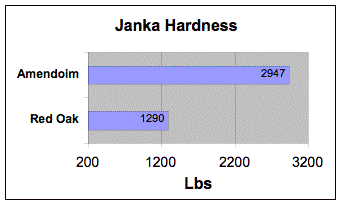
Amendoim exhibits a unique warm medium reddish tan/brown color with a lot of swirling grain and small burl figures. Over time, Amendoim will experience a medium degree of color change as this wood will mute and become a more uniform, darker tan-brown with reddish highlights. This specie is very hard and is recommended for commercial and domestic installations.


American Cherry
Botanical Name:
Prunus serotina
Also Known as:
Black Cherry, North American Cherry
Origin:
North America
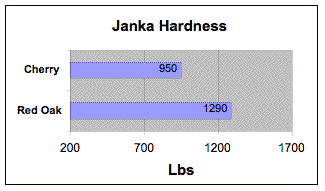
Prized for its rich color and fine graining, American Cherry is commonly seen in American cabinetry and furniture. The fine, satiny texture of the wood is uniform and frequently wavy, with distinctive gum veins and pockets. The lustrous heartwood ranges from light to reddish brown. American Cherry is extremely light sensitive, so there is a strong color change and darkening over a short period of time when the wood is first exposed to light. It is not considered a very hard specie.



Quilted Maple

Bird's Eye Maple

Curly Maple

Burl Maple
American Maple
Botanical Name:
Origin:
Also Known as:
Acer saccharum
North America (eastern United States and Canada)
Bird's-eye Maple, Black Maple, Curly Maple, Hard Maple, Rock Maple, Rough Maple, Sugar Maple, Sweet Maple, Thumbnail Maple.


North American Maple is the world’s premier “white” flooring wood and offers the lightest coloration of any wood flooring. The wood varies in color from the pale creamy white colored sapwood to a spectrum of tan/brown tones found in the heartwood. Maple undergoes a medium degree of color change, with slight ambering from a cream/white to a more golden cream color over time. The grain is closed with medium uneven figuring and uniform texture. Depending on the grain figuring, Maple is often referred as “quilted”, “curly”, "bird's-eye," or "fiddle back." During the grading process, interestingly figured boards are often culled from the group and sold at a premium. Because of its beautiful look and its relative hardness, Maple is the flooring of choice for dance floors, gymnasiums and bowling alleys.

American Walnut
Botanical Name:
Juglans nigra
Also Known as:
Black Walnut, Burbank Walnut, Eastern Black Walnut, and Virginia Walnut.
Origin:
North America. Native to the eastern United States, from southern Minnesota east to Pennsylvania, New Jersey, and New York, and south to the Carolinas, Georgia, Florida, and Alabama.

American Walnut is a highly sought-after wood, which ranges in color from a deep, rich dark, almost chocolate brown to a purplish black. The wood often has a purplish cast with dark and lighter streaks. There is a wide variation of color, figure, and grade in Walnut. The grain of Walnut is mostly straight and open, though some boards may have a grain pattern that is burled or curly.

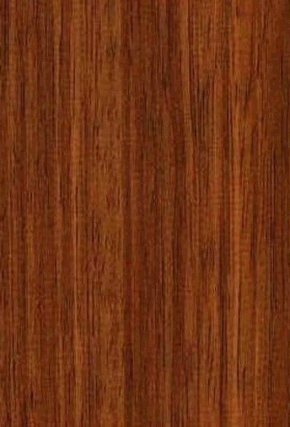
Angelique Teak
Botanical Name:
Dicorynia, guianensis
Also Known as:
Surinam and French Guyana
Origin:
Basralokus, Angelique batard, Angelique gris (French Guyana).

Angelique has a medium range of color varying from a tan nut-brown to medium browns. This specie is used as a substitute for Teak.
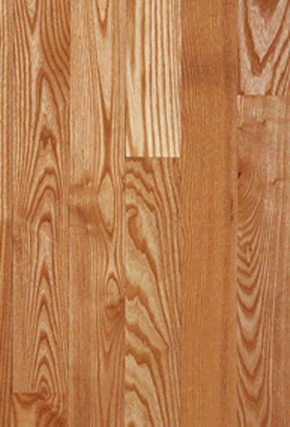
Ash
Botanical Name:
Fraxinus americana
Also Known as:
American Ash, Biltmore Ash, Canadian Ash, Fresno
Origin:
North America.

Ash exhibits a light tan to brown color, similar to White Oak but frequently more yellow. Its grain is bold and straight with occasional wavy figuring. Ash often has strong contrast in grain, especially in plainsawn boards. Its hardness is similar to Red Oak. In addition to flooring and other building structures, Ash is better known for baseball bats, e.g., the legendary "Louisville Slugger".


Asian Rosewood / Pradoo
Botanical Name:
Pterocarpus macrocarpus
Also Known as:
Pradoo
Origin:
Southeast Asia: Thailand, Burma, Indonesia
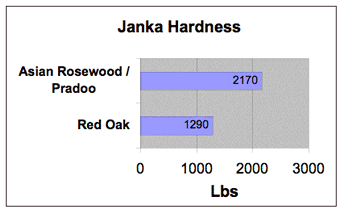
Asian Rosewood or "Pradoo" is one of the hardest and most durable timber in South-East Asia. Its color is more reddish and lustrous than its African and South-American counterparts. It has a sense of warm copper red color when varnished. It exhibits medium darkening overtime with exposure to light.


Australian Cypress
Botanical Name:
Callitris glauca
Also Known as:
New South Wales and Queensland (Australia)
Origin:
Cypress-Pine, Murray Pine, and Murray River Cypress.
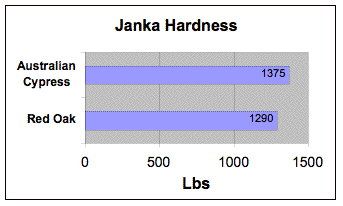
Australian Cypress exhibits a honey-gold to brown color with darker knots throughout, and a high degree of color variability. For a warm, rustic, cabin look, Australian cypress is an excellent choice. Over time there may be some slight ambering or muting of color tones. It has a fine, lustrous texture with a typically straight grain.

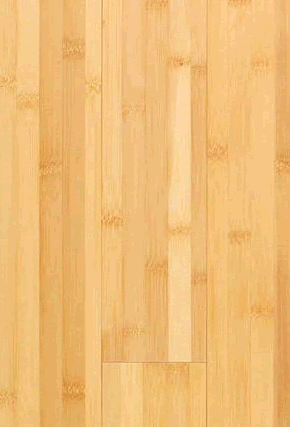
Bamboo
Botanical Name:
Phyllostachys, pubescens
Origin:
China and Southeast Asia
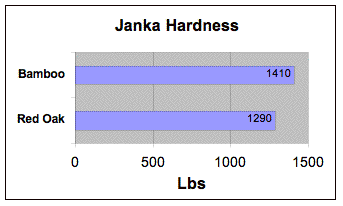

Bamboo describes a large number of species belonging to the Phyllostachys family. Strictly speaking, bamboo is not a wood but a grass. It is an attractive ecological alternative since it only takes about 4-5 years from planting to harvest time to prepare it for flooring applications. Harvesting does not kill the plant because it constantly regenerates itself by sending out runners that result in new canes.
To make bamboo flooring, the hollow round shoots are sliced into strips, which are boiled to remove the starch. The strips are then dried and laminated into solid boards, which are then milled into standard strip flooring profiles. Most manufacturers offer a light, natural color bamboo flooring and a darker, amber option, commonly known as carbonized. This amber color is achieved by pressure steaming the bamboo, which darkens it by carbonization. In addition to natural and carbonized, bamboo is also produced in a horizontal and a vertical pattern.

Beech
Botanical Name:
Fagus grandifolia
Also Known as:
American Beech
Origin:
North America.
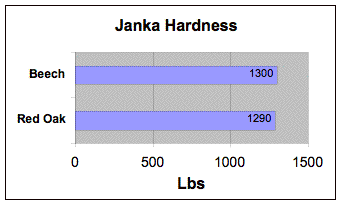
Beech exhibits a light brown reddish color with mostly fine, straight grain and uniform texture. There is moderate to high color variation between boards. Its hardness is similar to Red Oak. Beech is frequently used in factory floors and other high-traffic areas, since it wears well and stays smooth when subjected to repeated friction. The wood is hard and elastic, with excellent shock-resistance.


Birch
Botanical Name:
Betula spp
Origin:
Cherry Birch, White Birch
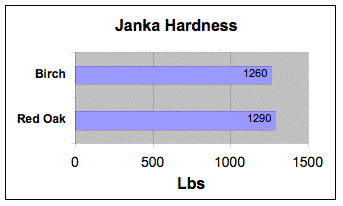

Birch exhibits a light brown caramel color tinged with red, and a straight close grain with even texture, frequently with a wavy figure in some boards. There are different types of Birch in the family: Sweet, Yellow, Paper Birch, etc. The most common type used for flooring is Yellow Birch, which can vary greatly in grain and color. Its hardness is similar to Red Oak.
Also Known as:
North America

Bolivian Rosewood
Botanical Name:
Machaerium, sclieroxylon
Also Known as:
Origin:
American BeechMorado, Moradillo, Pau Ferro, Santos Palisander, Caviuna
Bolivia, Brazil.

Bolivian Rosewood ranges in color from medium to light brown to almost black brown with purplish tones, and frequent black striping. This specie undergoes significant color change lightening overtime when exposed to sunlight.
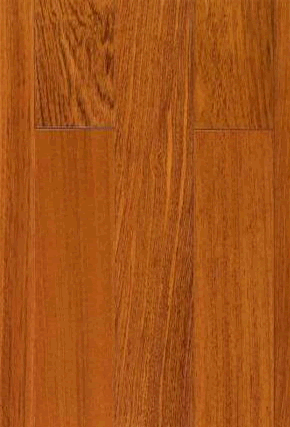
Brazilian Cherry
Botanical Name:
Hymenaea courbaril
Jatoba (Brazil), Guapinol, Copal (Central America), Paquio (Bolivia), Azucar Huayo (Peru).
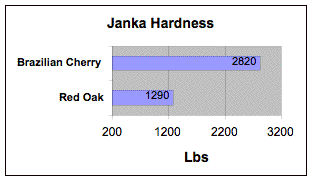

One of the most popular exotic hardwoods, Brazilian Cherry's color ranges from dark orange to dark brown with black streaks. Its grain is open like Red Oak. It is a very hard wood suitable for commercial installations. Brazilian Cherry is highly sensitive to color change as it darkens when exposed to light.
Also Known as:
Brazil, Paraguay, Bolivia, Peru, Central America.
Origin:

Brazilian Hickory
Botanical Name:
Patagonula bahiensis
Also Known as:
Guaiuvira
Origin:
Brazil, Paraguay, Argentina, Uruguay
.jpg)
Brazilian Hickory exhibits a caramel to dark brown color with abundant chocolate streaks and intertwined and irregular grain. It is a very hard wood used in furniture, construction and flooring.

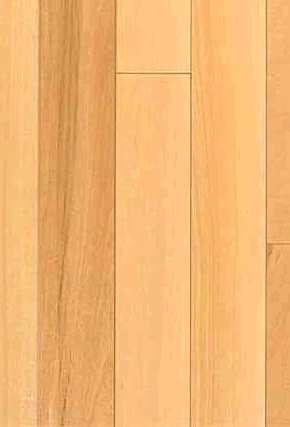
Brazilian Maple
Botanical Name:
Balfourodendron, riedelianum
Ivory Maple, Guatambu, Pau Marfin, Patagonian Maple, South American Maple
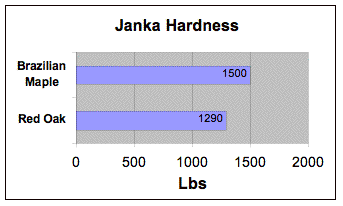

Brazilian Maple offers a medium range of color variability, ranging from pale cream colors to yellowish cream tones with distinctive curl markings. This specie exhibits a medium degree of color change, turning into amber, more golden cream color overtime.
Also Known as:
Brazil, Paraguay.
Origin:
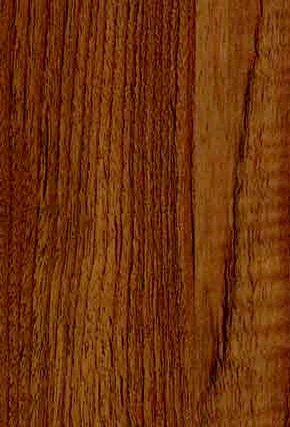
Brazilian Rosewood
Botanical Name:
Dalbergia nigra
Also Known as:
Jacaranda
Origin:
Brazil.
.jpg)
Brazilian Rosewood is an endangered specie and is currently illegal to export it in Brazil. For this reason it is nearly impossible to source it since it can only be obtained from trees harvested before 1992. Brazilian Rosewood ranges in color from brick red to violet with spidery black streaks known as spiderwebbing. The smell is like roses when freshly cut. Traditionally this specie has been used to produce musical instruments because of its excellent acoustics. Other similar-looking woods include Honduras Rosewood, Bolivian Rosewood and Indian Rosewood

Caribbean Rosewood
Botanical Name:
Metopium, browneii
Also Known as:
Chechen, Poison Wood
Origin:
Mexico, Belize and Guatemala.
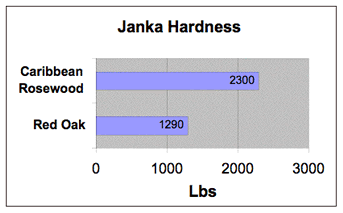
Caribbean Rosewood exhibits extreme color variability ranging from cream colored, flame type, swirls to gold/orange highlights on top of a medium brown background with black striping. Caribbean Rosewood exhibits a medium degree of color change darkening overtime.

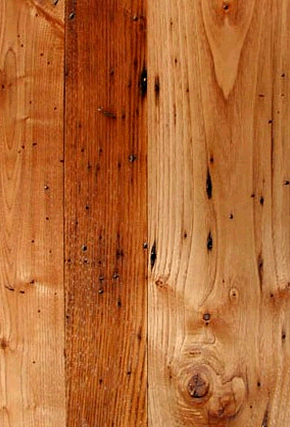
Chesnut
Botanical Name:
Also Known as:
Origin:
Castanea dentata
American Chestnut, Chinkapin, Sweet Chestnut, European Chestnut, Japanese Chestnut, Chinese Chestnut, Sequin’s Chestnut, Henry’s Chestnut.
North America
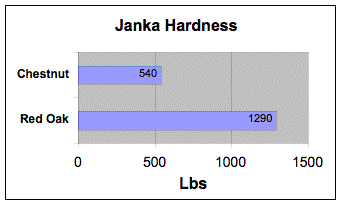
Chestnut (Castanea), is a genus of eight or nine species of trees and shrubs in the Beech family (Fagaceae), native to warm temperate regions of North America. The American Chestnut, formerly one of the dominant trees of eastern United States, was almost wiped out by a fungal disease, Chestnut blight, in the early 1900’s. Since it is almost extinct, American Chestnut flooring is very scarce and sold at a premium as it can only be produced from antique recovered timber coming from very old farm houses, barns, schools, factories and older buildings. The characteristics of this floor, known as Antique Wormy Chestnut, include wormholes, random nail holes and gray oxidation marks. Other Chestnut varieties available today are the European and Asian Sweet Chestnut.
Chestnut ranges from a cream/tan color with ash-like graining to a dark uneven brown often with spiraling and darker knots. Chestnut ambers over time to a medium and dark tan/brown color. It is a very soft wood.

Cork
Botanical Name:
Quercus suber
Origin:
Portugal, Spain, Morocco, Algeria, Tunisia, and the Mediterranean Europe Basin.




What is commonly referred as cork is actually the bark of the Cork Oak tree. As the bark is removed for cork production, the tree grows again in about 8-10 years, making it a renewable resource. Cork is impervious to water due to the interconnected nature of its "honeycombed" and airtight cells. Comprised of a countless number of individual air-filled cells, cork offers a very unique appearance. Depending upon how the flattened bark is cut, cork can reveal any of a number of distinctive surface designs.
Cork is a very soft flooring option. It’s pliant nature however, allows for the floor to expand and contract upon stepping on it. It is not recommended for high traffic areas. Cork flooring's two styles are tiles and planks, and it comes in a range of natural colors. Tiles are glued down and planks are generally floated.

Athene Gray
Odysseus Brown
Odysseus Rose

Brazilian Teak
Botanical Name:
Also Known as:
Origin:
Dipteryx Odorata.
Peru, Brazil, Bolivia, Colombia, Venezuela and Costa Rica
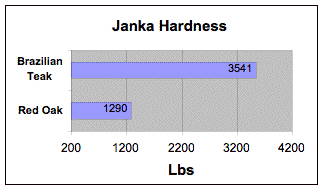
Brazilian Teak is a high quality and extremely hard wood with an attractive uniform light tan brown color. It presents a fine texture with interlocked grain, and is one of the most durable and dense hardwoods on the market. Brazilian Teak is normally available in a tan brown color with mixed lighter and darker tones, usually referred as Light Cumaru. A more rare type of Brazilian Teak is Red Cumaru which features reddish and darker brown tones, similar to Brazilian Cherry or Santos Mahogany. Given its extreme durability and quality, Brazilian Teak is ideal for commercial and residential installations with heavy traffic.

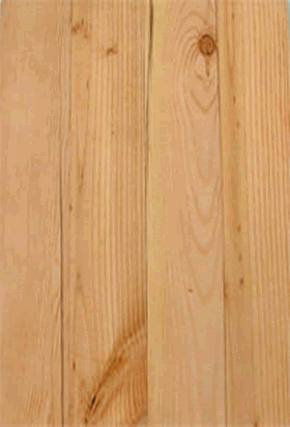
Douglas Fir
Botanical Name:
Pseudotsuga menziesii
Also Known as:
Red Fir, Yellow Fir
Origin:
North America
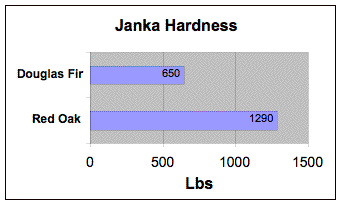
Douglas Fir has a yellowish tan to light brown color, often confused with Southern Yellow Pine. Lumber from young trees have reddish heartwood and are called Red Fir. The narrow-ringed wood of older trees may be yellowish-brown and is known as Yellow Fir. Douglas Fir has a significant color change upon exposure to light. Its grain is normally straight with occasional wavy or spiral texture. This specie of wood is very light and not very hard.


Doussie
Botanical Name:
Also Known as:
Origin:
Afzelia africana
Afzelia, Afa, Beyo, Lingue, Papayo, Uvala
Central and West Africa

This specie exhibits an orange/brown color with straight and slightly interlocked grain. Doussie undergoes substantial color change with pronounced darkening from a light orangey brown to a deeper mahogany color over time. Its uses include fine flooring, furniture, decking, stair rails, and construction.
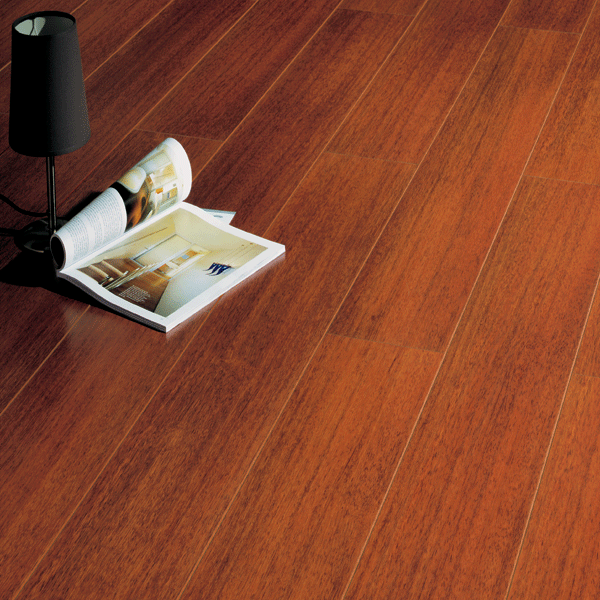

Gingerwood
Botanical Name:
Chlorophora tinctoria
Also Known as:
Tatajiva, Old Fustic, Barossa, Moral, Palo de mora, Dinde, Palo amarillo, Mora, Insira, Amarillo, Taiuva, Amarello, Tatayiva-saiyu.
Origin:
Brazil, Paraguay, Bolivia
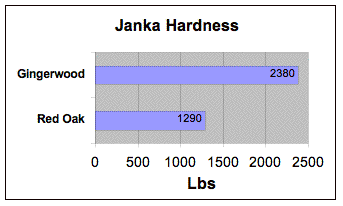
This wood has a straight grain with growth rings that are barely visible. There is a significant change in color from the freshly sanded and finished wood to the matured floor. When fresh, this wood is very yellow and light in color. Within a few weeks to months it will mature to an overall deep golden-brown color. This is a very hard wood ideal for commercial and residential installations.

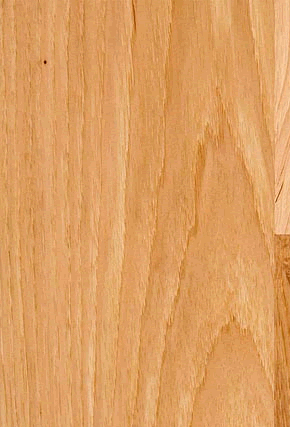
Hickory
Botanical Name:
Carya spp
Also Known as:
Pecan Hickory, Bitter Pecan, Sweet Pecan, Nogal Morado, Nuez Encarcelada, (Mexico)
Origin:
North America and Mexico
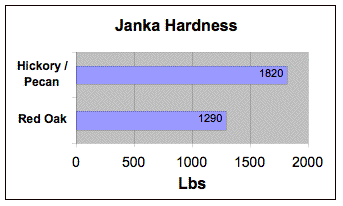
While strictly speaking they are different wood species, Hickory and Pecan are very similar and often mixed by flooring mills. Hickory/Pecan has a light tan yellow color with pinkish tones, and fine brown lines. Its grain is open, and occasionally wavy or irregular. This specie is a favorite among log cabin owners since it exhibits a more rustic and less uniform look. Compared to other North American species, Hickory/Pecan is significantly harder and more resistant to traffic.

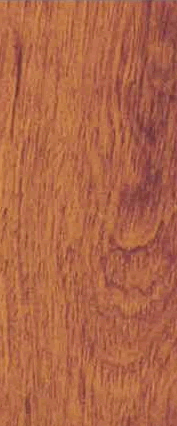
Honduras Rosewood
Botanical Name:
Dalbergia, stevensonii
Also Known as:
Tatajiva, Old Fustic, Barossa, Moral, Palo de mora, Dinde, Palo amarillo, Mora, Insira, Amarillo, Taiuva, Amarello, Tatayiva-saiyu.
Origin:
Central America, Mexico
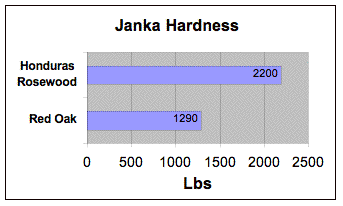
Honduras Rosewood exhibits a rich purplish burgundy color, which lightens over time to brownish tones. This specie is restricted in certain a parts of Belize since it is being overexploited. It is commonly used in the production of furniture and musical instruments.

Ipe / Brazilian Walnut
Botanical Name:
Tabebuia spp
Also Known as:
Ipe (Brazil), Lapacho Negro (Paraguay and Argentina), Cortez (Central America), Guayacan Polvillo (Colombia), Flor Amarillo, Madera Negra (Ecuador), Tahuari (Peru), Ironwood, Pau Lope, Greenheart (Surinam).
Origin:
North America and Mexico
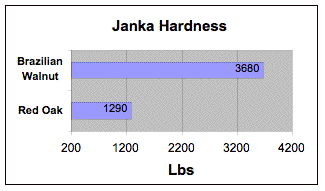
Brazilian Walnut (Ipe) has a light to dark olive brown color, often with attractive lighter and darker striping and striking contrasts. The color of the boards changes from a dark brown to a lighter green olive. It has a fine texture, medium luster, and a somewhat oily appearance. Ipe is one of the hardest species in the world (three times as hard as Red Oak), and very heavy. Because of its compact, hard and oily nature, Ipe is often used in outside constructions such as decking and building structures. Ipe is very similar in color and properties to Lapacho, but strictly speaking is a different specie.


Honduras Mahogany
Botanical Name:
Swietenia macrophylla
Also Known as:
Honduras Mahogany, Brazilian Mahogany, Caoba, Big Leaf Mahogany
Origin:
South and Central America, Caribbean, Far East

Mahogany is regarded by many as the world's premier wood for fine cabinetry, high-class furniture, trimming fine boats, pianos and other musical instruments. This specie has been heavily exploited and is already extinct in parts of its original range. It is very rarely used for flooring due to its scarcity, high price, and relative softness. Mahogany’s colors range from light salmon to a dark reddish-brown to even a deep crimson red.
Because of its scarcity, there are several substitute species that are similar in color and can be used for flooring: Santos Mahogany, Lyptus, African Mahogany, Sipo and Sapele.
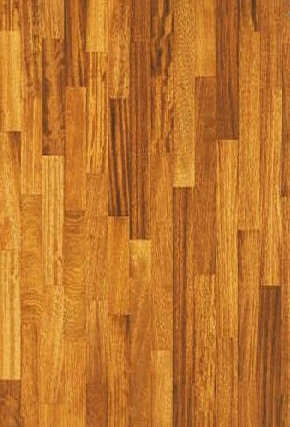
Iroko / Kambala
Botanical Name:
Chlorophora excelsa
Also Known as:
African Teak, Abang, Lusagna, Moreira, Molundu, Odum, Semli
Origin:
Ghana, Gabon, Guinea, Congo
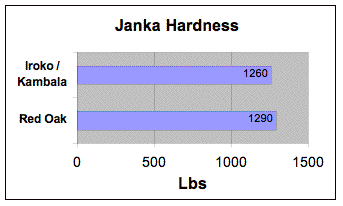
The color of this wood varies from pale golden brown to dark chocolate brown, exhibiting a high degree of color change with pronounced darkening when fully oxidized. This hardwood is sometimes used as a substitute for Teak because of its similar grain and color.

Jarrah
Botanical Name:
Eucalyptus marginata
Also Known as:
Jerryhl, Swan River Mahogany
Origin:
Southwestern Australia
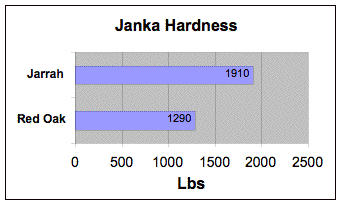
Jarrah presents a pinkish to dark red color, often with a deep dark red mahogany hue, and frequent black streaks with occasional interwoven grain. It exhibits a high degree of character and color variation from board to board.
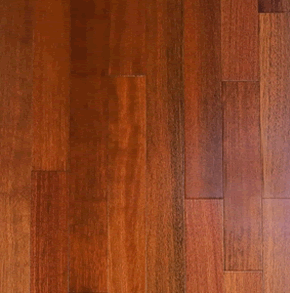
Kempas
Botanical Name:
Koompassia malaccensis
Also Known as:
Impas, Mengris, Thongbeung
Origin:
Malaysia and Indonesia.
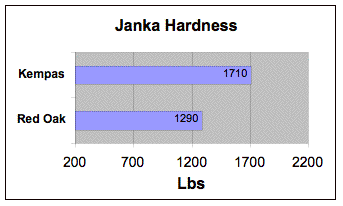
Kempas is a course grained, very hard, and pink to reddish color wood, with medium graining. It exhibits a wide range of color variability from a pale pink-tan color to a medium dark-reddish color. The grain is interlocked and often varies from coarse to even.



Lapacho
Botanical Name:
Tabebuia heptaphylla
Also Known as:
Pau d'arco, Taheebo, and Ipe roxo.
Origin:
Brazil, Paraguay, Bolivia, Peru and Venezuela.

Lapacho has a general olive brown hue, often with lighter yellowish or dark green stripes. The grain varies from straight to irregular with quite a bit of figure showing in several pieces. Lapacho is very similar in appearance to Ipe/Brazilian Walnut, but somewhat lighter in color with a greener hue. Ipe is mostly available in Brazil while Lapacho is more prevalent in Paraguay, Argentina and Bolivia. Both Ipe and Lapacho are incredibly durable and hard species and are commonly used for decking, outdoor construction and flooring.

Lyptus
Botanical Name:
A natural hybrid of Eucalyptus grandis and E. urophylla
Origin:
Brazil and Uruguay

Lyptus® is a premium plantation-grown hardwood developed in Brazil using proprietary technology in a sustainable and environmentally responsible manner. Lyptus® is harvested in just 14 to 16 years, much faster than other premium hardwoods grown in colder climates, ensuring reliable supplies throughout the foreseeable future. Lyptus® is a wood with the appearance of cherry and the grain of fine mahogany, varying in color from reddish tan to light brown

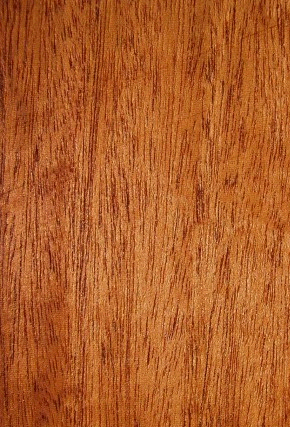
Mahogany
Botanical Name:
Swietenia macrophylla
Also Known as:
Honduras Mahogany, Brazilian Mahogany, Caoba, Big Leaf Mahogany
Origin:
South and Central America, Caribbean, Far East
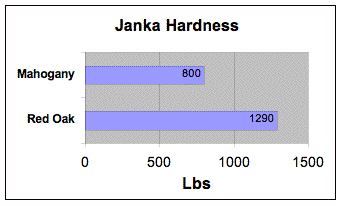
Mahogany is regarded by many as the world's premier wood for fine cabinetry, high-class furniture, trimming fine boats, pianos and other musical instruments. This specie has been heavily exploited and is already extinct in parts of its original range. It is very rarely used for flooring due to its scarcity, high price, and relative softness. Mahogany’s colors range from light salmon to a dark reddish-brown to even a deep crimson red.
Because of its scarcity, there are several substitute species that are similar in color and can be used for flooring: Santos Mahogany, Lyptus, African Mahogany, Sipo and Sapele.
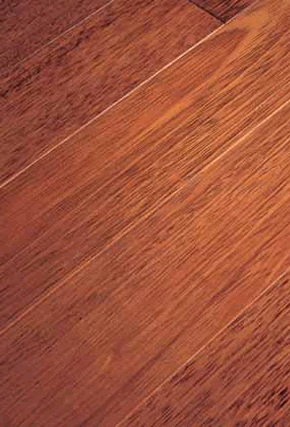
Merbau
Botanical Name:
Intsia palembanica
Origin:
Indonesia, Malaysia, Philippines, India, Burma, Australia, and Polynesia.
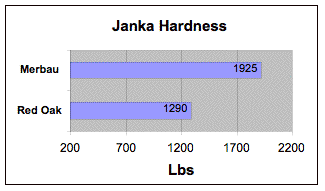
Merbau is a medium brown color wood with reddish/orange highlights with a course graining. One of the distinctive properties of this wood is that the surface of the boards may have yellow "flecking" in the pores; thus, when finished, the wood may appear almost flecked with gold. Merbau undergoes a medium to large degree of color change darkening over time to deeper orangey brown.

Also Known as:
Aizella, Ipil, Ifelele, Kwila, Lumpha.

Mesquite
Botanical Name:
Prosopis glandulosa
Also Known as:
mizquitl (aboriginal name), algarrobo (Chile)
Origin:
South and Central America, Mexico, Southwestern United States, Middle East and Africa.
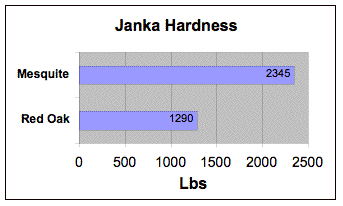
Mesquite is one of the hardest and most durable of all Native American woods. There are approximately 60 varieties of mesquite wood worldwide, but the most common one in the United States is the South Texas variety. Mesquite is harder than most other North American species used for flooring. Having evolved in desert climates with unpredictable water supply, Mesquite does not shrink as it ages. It exhibits a dark brown to light reddish brown color with a high degree of character and variation on the grain, including, knots, ingrown bark and mineral streaks. It is not unusual to find small irregular cracks radiating across the grain.

Padauk
Botanical Name:
Pterocarpus soyauxii
Also Known as:
African Coralwood, Barwood, Bosulu, Comwood, Corail, Mbe, Mbil, Mtuti, Ngula, Vermillion, Yomo
Origin:
Central and Tropical West Africa
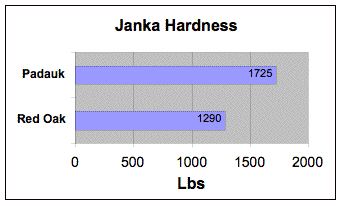
Padauk has a rich reddish orange tone, which over time seasons nicely to a dark reddish or purple-brown color. African Padauk undergoes an extreme degree of color change with pronounced darkening from the vivid orange color when freshly milled to a dark red almost black color when fully aged/oxidized. Oil finishes hasten this process and allow the full color change to occur while water based finishes inhibit the full color range.

Pearwood
Botanical Name:
Guarea spp
Also Known as:
Moabi
Origin:
Nigeria, Gabon, Congo and Ivory Coast
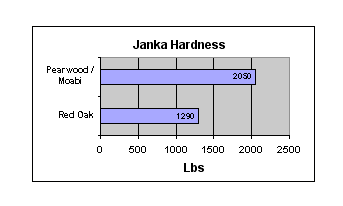
African Pearwood exhibits a pinkish brown color with a slight darkening with age resembling a caramel color. Pearwood/Moabi is one of the largest trees in the forests of Equatorial Africa; it routinely reaches a height of 200 feet with 10-foot diameters and straight cylindrical boles to 100 feet. Pearwood is used as lumber and veneer in a variety of uses. It is extremely tough with high bending strength. Works well with most hand and machine tools.

Pepperwood/ Patagonian Rosewood
Botanical Name:
Piptadenia macrocarpa
Also Known as:
Curupay, Curupayte, Kurupayte, Angico preto, Cebil, Cebil colorado, Curupay-ata, Kurupay-te, Curupaú, Willca, Curupaí, cebil moro Curupa-í, Curupa-í pitá Coboba, Cohoba, Yupa, Yopa, Pariká, Kurupa, Hatax, Jataj.
Origin:
Brazil, Paraguay, Bolivia, Argentina, Uruguay

The overall appearance of Pepperwood ranges from red to dark brown, becoming a deeper red over time. This specie exhibits distinctive black growth rings and streaks, which become less evident over time. Jointly with Ipe, Pepperwood is the hardest specie available in the flooring market.


Peruvian Cherry
Botanical Name:
Also Known as:
Origin:
Manilkara Bidentata
Quinilla (Peru), Zapote, Mame Colorado, Balata, Cochinillo, Cuberu, Masaranduba, Nisperillo, Nispero (Venezuela), Caimitillo, Leche de Platano, Trapichero (Colombia).
Brazil, Peru, Ecuador, Venezuela and Colombia.
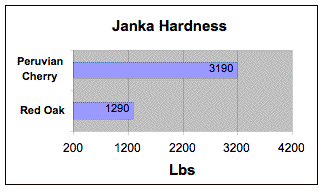
Peruvian Cherry is a high quality hardwood with a light chestnut-brown color when first milled, turning into a beautiful and rich deep reddish-brown color over time. Peruvian Cherry has a low to medium gloss and is one of the best, hardest and longest-lasting woods available on the market. While the tone, grain, and pattern are the same as Brazilian Cherry, Peruvian Cherry is more durable and less light sensitive. Given its extreme hardness and top quality, Peruvian Cherry is ideal for both residential and commercial installations.

Peruvian Maple
Botanical Name:
Aspidosperma Macrocarpon.
Also Known as:
Pumaquiro (Peru), Guatambu (Brazil), Araracanga.
Origin:
Brazil, Peru, Venezuela, Colombia, Surinam and Paraguay
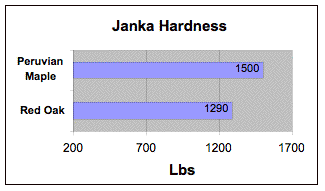
Peruvian Maple is a fine exotic hardwood with a vivid light tan yellowish color, turning into a beautiful and rich honey color over time. Peruvian Maple presents a medium to high gloss and is used for both residential and commercial installations.

Pine
Botanical Name:
Pine describes a whole variety of wood species, which are traditionally broken down into four main subgroups: Southern Pines, Fire Pines, White Pines, and "Old World" Pines.
Origin:
North America into Central America, as well as Northern Europe and the former Soviet Republics.
Also Known as:
Caribbean Heart Pine (Pinus caribaea)
Eastern White Pine (Pinus strobus)
Southern Yellow Pine – Loblolly (Pinus taeda)
Southern Yellow Pine – Longleaf (Pinus palustris)
Southern Yellow Pine – Shortleaf (Pinus echinata)
White Cypress Pine (Callitris glauca)
Pine colors vary from specie to specie but in general it has a light orange-yellow to red or yellowish-brown color. The wood has a closed grain varying in figuring amongst the species. The grain is usually straight, sometimes irregular with knots that can vary from ¼” to 2”. The term “Heart Pine” does not refer to a particular specie but to the heartwood of the tree. Heart Pine as it is commonly called today comes from older Longleaf or Loblolly pine often salvaged from older building structures or reclaimed from rivers.



Purpleheart
Botanical Name:
Amaranth peltogyne spp
Also Known as:
Amaranth, Amarante, Guarabu, Koroboreli, Morado, Palo Morado, Pau Roxo, Purperhart, Tananeo, Violetwood.
Origin:
Amazon and Central America
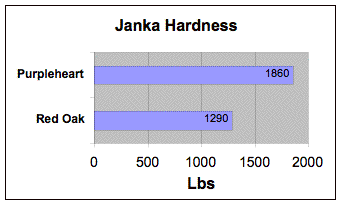
Purpleheart is one of the world's most unique woods in that it is truly purple, with little color variation over time.. This wood is very dense and with fine graining. Purpleheart is prized for its uniquely vivid purple color, and so it is used in many specialty items, such as billiard cue butts and decorative carving. As a flooring material, the wood makes for very dramatic edgings, inlays, and accents. It is also used widely in parquet, fine furniture and cabinet work.


Pyinkado
Botanical Name:
Xylia dolabriformis
Also Known as:
Myanmar Ironwood, Irul (India), Sokram (Cambodia), Cam Xe (Vietnam), Deng (Thailand)
Origin:
Burma (Myanmar), Cambodia, India, Thailand, and Vietnam.
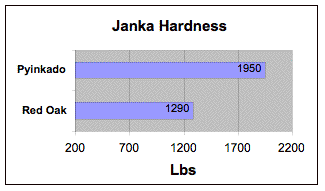
Pyinkado has beautiful deep reddish-brown tones with dark grain streaks or faintly veined darker lines. It turns to dark reddish-brown with aging. The grain varies from straight to broadly interlocked, sometimes wavy. Pynkado has high strength properties, and is very durable.


Red Oak
Botanical Name:
Quercus spp.
Also Known as:
Black Oak, Buck Oak, Grey Oak, Eastern Red Oak, Spanish Oak, Southern Red Oak, Water Oak.
Origin:
North America
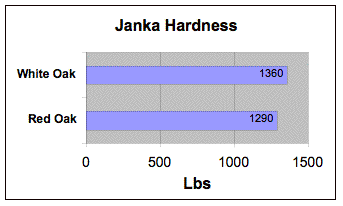
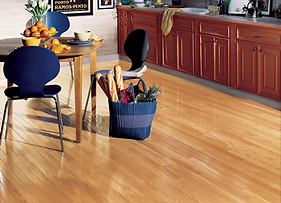
Red Oak is the most common flooring specie in the United States with over 200 sub-species across North America. Red Oak has a light caramel color with a tint of red-pink grain. There is noticeable variation in color and grain depending on the origin of the wood and corresponding differences in growing seasons. The most common flooring types are Northern, Southern and Appalachian. As a general rule, the Northern and Appalachian types have a more uniform grain and color pattern because they grow slower than the Southern type and, consequently, they are slightly higher priced.
Depending on whether the wood is plainsawn, riftsawn, or quartersawn, the grain of Red Oak can have a plumed or flared appearance, a lighter grain pattern with low figuring, or a "flake" pattern that is referred to as "tiger rays" or "butterflies."

Santos Mahogany (Cabreuva)
Botanical Name:
Myroxylon Balsamum
Also Known as:
Estoraque (Peru), Cabriuva Vermelha (Brazil), Quina (Bolivia), Balsamo (Colombia), Sandalo (Ecuador), Quina Morada (Venezuela), Nava, Red Incienso.
Origin:
Brazil, Peru, Paraguay, Bolivia, Colombia, Panama, Guatemala and Mexico.
Santos Mahogany is a high quality exotic hardwood with a reddish brown color when first milled, which turns into a rich dark mahogany color over time. Santos Mahogany hardwood normally offers a range of overtones from a light orange/brown to a dark reddish/brown. It has a medium to high gloss, and is as beautiful as it is durable, making it a very appealing selection. Given its durability and top quality, Santos Mahogany hardwood is ideal for both residential and commercial installations.


Sapele
Botanical Name:
Entandrophragma cylindricum
Also Known as:
African mahogany, Sapelli, Abroudikrou, Penkwa, Undianuno
Origin:
Nigeria, Ivory Coast and Cameroon
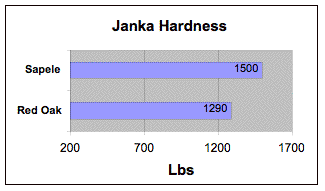

One of the most popular of the African species, Sapele has a dark brown-reddish color that in many ways is very similar to Mahogany. On quartered surfaces the wood presents a well-defined ribbon striped figure. The grain is interlocked or wavy and the texture is fairly fine. Sapele is about 20% harder than Red Oak.

Tauari
Botanical Name:
Couratari spp
Also Known as:
Brazilian Oak, Brazilian Beech, caouroubara, couratari
Origin:
Brazil, Costa Rica, Panama, Venezuela, Colombia
Brazilian Oak ranges from a relatively uniform light straw color when freshly milled, to a medium brown color when exposed to light and fully oxidized. Its grain is uniform and straight.
.jpg)
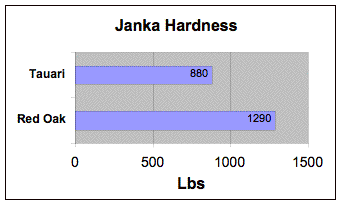

Teak
Botanical Name:
Tectona grandis
Also Known as:
Burma Teak, Djati, Gia Thi, Jati Sak, Kyun, Mai Sak, Pahi, Rangoon Teak, Rosawa, Sagon, Sagwan, Tadi, Teca.
Origin:
Indonesia, Burma, Costa Rica
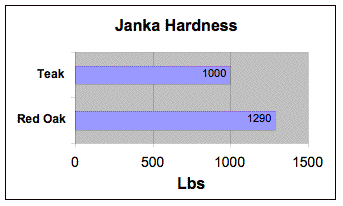

Teak has been prized for centuries as one of the worlds most durable and stable woods for outdoor use. Traditionally used on boats and in outdoor furniture, Teak has also been widely used for flooring. Teak exhibits a dark golden-brown to dark golden-yellow color with darker chocolate-colored brown streaks. The species has a straight, occasionally wavy grain and is fairly coarse and uneven in texture.

Tiete Chestnut (Sucupira)
Botanical Name:
Bowdichia Nitida
Also Known as:
Sucupira (Brazil), Almendrillo (Colombia), Peonia (Venezuela), Tatabu, Aramatta (Guyana), Zwarte kabbes (Surinam), Coeur dehors (French Guiana),
Origin:
Brazil, Colombia, Venezuela, Guyana
Tiete Chestnut exhibits a tan to dark brown color with unique interlocking grain pattern and occasional black striping. Color is mostly unaffected by exposure to light. This is a very hard and resistant wood adequate for commercial and domestic installations.



Tiete Rosewood
Botanical Name:
Guibourtia, chodatianal
Also Known as:
Patagonian Cherry, Sirari, Madeira Nova, Kuruguay
Origin:
Brazil, Paraguay, Bolivia

Tiete Rosewood exhibits a range of color variability between pale pinks to darker purplish reds with occasional dark striping. This wood undergoes a medium degree of color change from a pink red to a slightly deeper medium red. It is an extremely hard wood that will perform well in high traffic areas.


Tigerwood
Botanical Name:
Astronium, Spp
Also Known as:
Goncalo Alves, Muiracatiara (Brazil)
Origin:
Brazil, Bolivia, Peru, Guatemala, Mexico.
Tigerwood is a boldly striped wood, which has an orangish/reddish brown background with wide dark brown/black striping. The striping can vary from fine lines to bold "brush strokes". The background color can range from light tans to darker orange browns. Tigerwood exhibits a large degree of color change with a pronounced darkening of the background under the stripes from an orangey tan to a deep reddish brown color, which then in turn makes the striping less contrasting and subtler. It is a tight grained very durable wood.
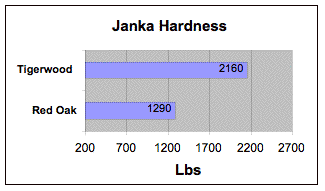


Timborana
Botanical Name:
Piptadenia, suaveolens
Also Known as:
Angelium, Angico, Batibatra, Cobi, Jebio, Golondrino, Harino, Hevio, Menudito, Timbauba, Yiguire
Origin:
Brazil, Venezuela, Colombia, Guyana, Central America
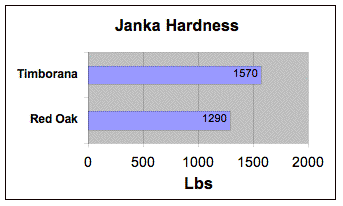
Timborana is a wood with a light tan yellow color, which darkens to a tan brown color when fully oxidized. Its grain is straight or interlocked and sometimes it shows some curly patterns.
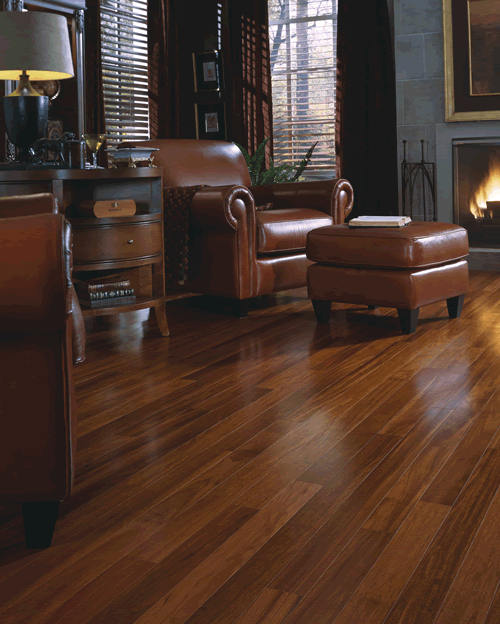

Wenge
Botanical Name:
Milletia spp.
Also Known as:
Panga-panga, Awong, Mpande
Origin:
Central Africa, especially Congo and southern regions of Tanzania and Mozambique.
Wenge has a uniform dark chocolate brown color that is used primarily for contrasting accent strips or in those areas desiring a bold dark look. A similar specie is known as Panga-panga and has the same grain but does not darken as much.



White Oak
Botanical Name:
Quercus alba
Also Known as:
Basket Oak, Chestnut Oak, Cow Oak, Mountain Oak and Rock Oak.
Origin:
North America
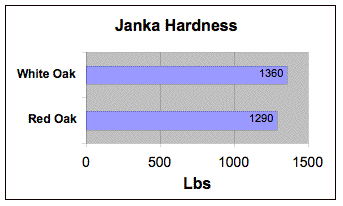
White Oak is an American classic used widely in cabinetry, furniture and flooring. It has a medium to high degree of color variability and ranges from light tan to medium tan colors, with a grayish cast. Its grain is open with longer rays than Red Oak and occasional swirls and burls. Depending on whether the wood is plainsawn, riftsawn, or quartersawn, the grain of White Oak can have a plumed or flared appearance, a lighter grain pattern with low figuring, or a "flake" pattern that is referred to as "tiger rays" or "butterflies."
